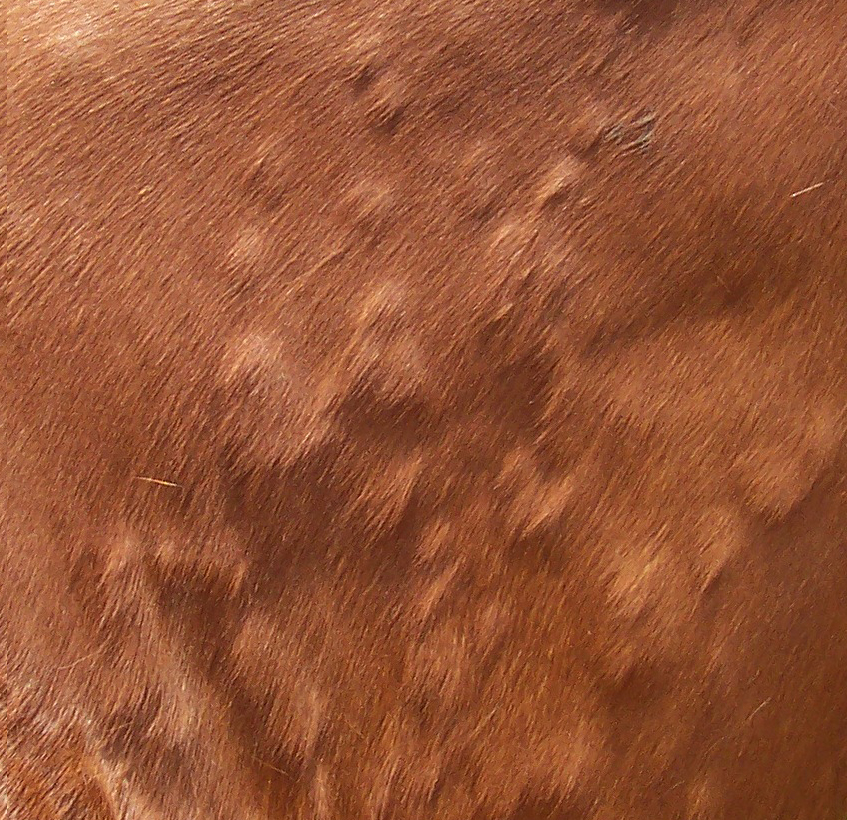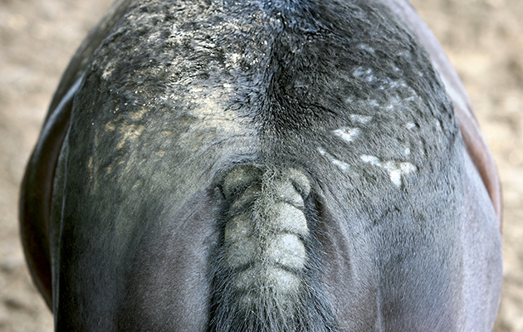
By Dr Andy Richardson BVSc CertAVP(ESM) MRCVS, NAF Veterinary Director

The Problem
Long-standing itchy skin is one of the most frustrating conditions for both horse owners and veterinarians alike. Understanding the cause and managing the signs can be a complex process.
The sensation itch in horses has multiple potential consequences, including:
The Cause
There are many potential underlying causes of skin irritations in horses:

Fact Busting – Allergens, Hypersensitivity and Urticaria
An allergen is a substance that causes an allergic reaction. Allergens are usually harmless substances that are capable of triggering a response in susceptible individuals. This process starts in the immune system and results in an abnormally vigorous response called a hypersensitivity reaction. For allergens that cause skin problems, that reaction usually causes itchiness, raised bumps or swellings in the skin known as urticaria.
Sweet Itch
What Is It?
Horses with sustained itchiness during spring/summer months are most commonly affected1 by a form of Insect Bite Hypersensitivity that is commonly referred to as ‘Sweet Itch’. Sweet Itch is caused by a specific allergy to the saliva of the Culicoides species of biting midge. The Culicoides species of midge are distributed worldwide amongst horse populations, with the only exception being Iceland1.

There is a strong seasonal pattern to Sweet Itch that coincides with the seasonal activity of the midges, so the condition occurs only from late spring to late autumn. In long standing cases, the clinical signs may be present during winter months as well, although alternatives causes of year round skin irritations should be strongly considered first.
Diagnosis
A diagnosis of Sweet Itch is usually achieved by a combination of the presence of the Culicoides midge, the seasonal nature of the clinical signs and the classical distribution of the lesions. Serological (blood) or intra-dermal testing may also be useful although results can be inexact.

Clinical Signs
Typical clinical signs of Sweet Itch result from the intense itchiness and subsequent self-trauma that result:
Management
Separating the horse from the midge is the obvious solution, however in practice this is extremely difficult. As the condition is caused by an allergic response to the saliva, the itchiness can be triggered by a small number of bites. Stabling in an insect-proof stable during the day, along with fan-assisted ventilation can help, as midges are weak fliers. In addition, frequent application of insect repellents is advisable.
In terms of managing the signs once they occur, the primary pharmaceutical management involves the use of corticosteroids. Long-term corticosteroid use has been associated with side effects, so horses receiving this therapy require careful monitoring for laminitis in particular2.
Natural plant based antioxidants and support for the anti-inflammatory response have been used to beneficial affect for managing the severity of skin irritations and relieving the intensity of the clinical signs.
Managing the Itchy Horse or Pony
Some specific causes of skin irritations that can be readily diagnosed have specific and effective treatments. Some examples would be ectoparasites such as lice or mites, or fungal skin disease such as Ringworm.
Allergic skin disease is much more challenging to both diagnose the precise trigger but also to manage. As discussed in the section above, Sweet Itch is one particular form of allergic skin disease.
If the offending cause of allergic skin disease can be identified, then removal of that specific allergen will clearly be the most effective solution. The reality is that trying to identify the specific allergen can be very difficult. Excluding potential allergens from the environment and monitoring the horse for an improvement in severity of signs is the principle behind exclusion testing, however it can be a long and frustrating approach. Serum and intradermal allergen testing aims to solve this problem by looking for the specific allergen, however it is not an exact science results can be equivocal, often suggesting multiple allergens as the cause. Even if the offending allergen(s) can be identified, completing eliminating them from the horse’s environment may not be possible – the Culicoides midge that causes sweet itch would be a good example.
So what are the options for controlling and relieving signs of allergic skin disease if the allergen cannot be completely eliminated? Traditionally the mainstay of pharmaceutical management has been the use of corticosteroids. Corticosteroids act by dampening down the immune response and therefore reducing the severity of the itchiness that follows. Long-term use of corticosteroids should be approached with caution and discussed with your vet due to concerns over side-effects, not least as each individual horse will have a different degree of risk. Research into the link is ongoing, however there is concern over the potential for corticosteroids to induce particularly severe laminitis in isolated cases. This risk may be exacerbated following long-term use.
Research is also ongoing into the potential for adaptogenic herbs to support a normal immune response and thus be an additional option for helping to relieve and control. Whilst further studies in horses are required, a study carried out by an American Veterinary College of a synergistic blend of herbal ingredients for the control of allergic skin disease in dogs showed some promising results3.
Selected References:
NAF © 2024 | NAF is a trading name of Greencoat Limited, registered in England & Wales. Greencoat Ltd - Registered address: Weston Centre, 10 Grosvenor Street, London, W1K 4QY. Registered Number: 1560 108. Registered in England & Wales.Number: 1560108 VAT Registration Number: 378 9295 80